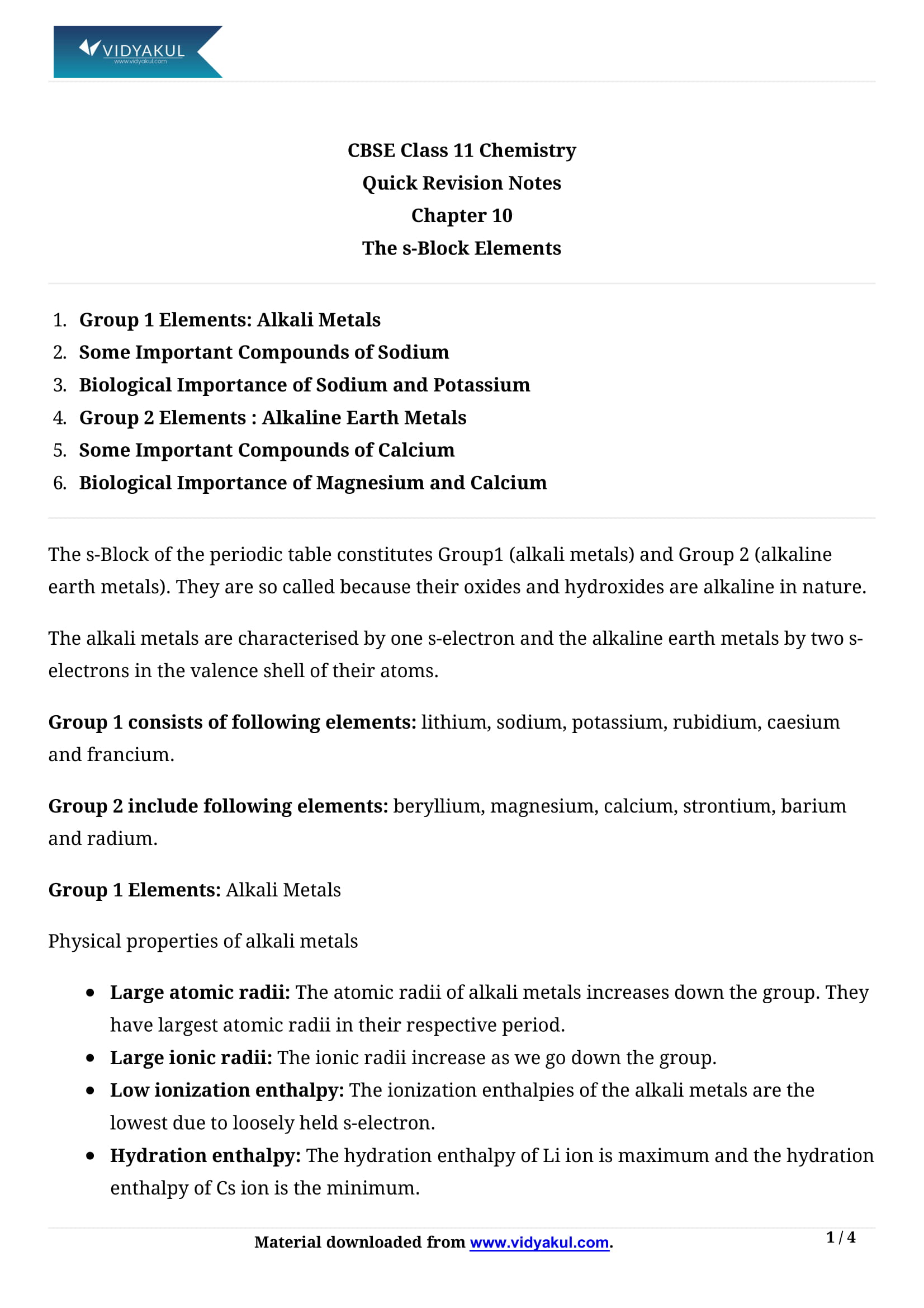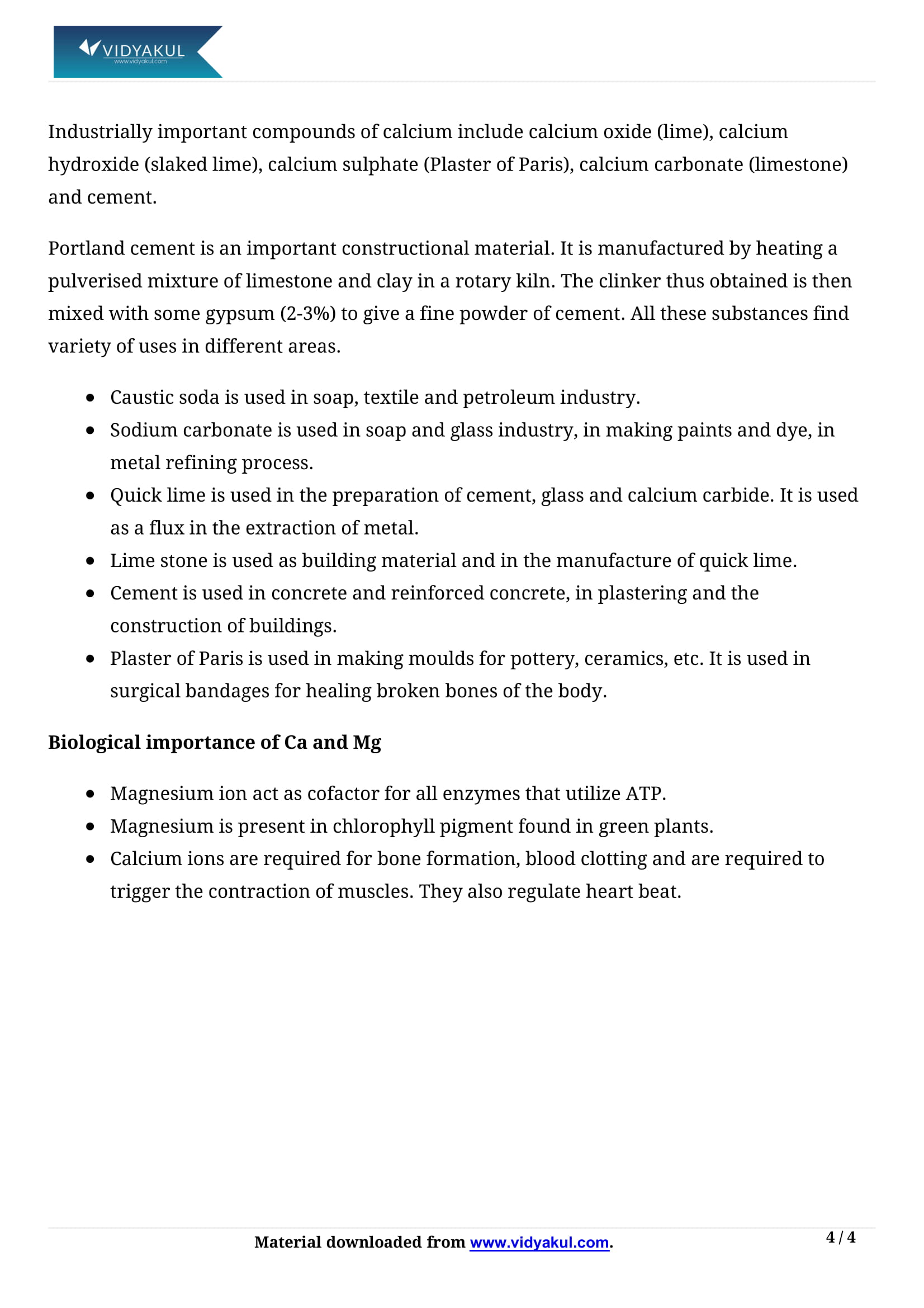The s-Block Elements Class 11 Notes

Chapter 10 The s-Block Elements
Elements in groups 1 and 2 of the periodic table are called s-block elements. Group 1 elements are called alkali metals, and group 2 elements are called alkaline earth metals. They are so named because of the alkalinity of oxides and hydroxides. Two s-electrons characterize alkaline earth metals, while alkali metals feature one s-electron in the valence shell of their atoms. Both of these metals form mono-positive and negative ions and are highly reactive.
Let's take a quick look at topics, s-box elements, subtopics, and more.
CBSE 11th CHEMISTRY CH-10
Points to Remember
Gp. 1 Elements: Alkaline metals Electronic configuration, Atomic & Ionic radii Ionization enthalpy, hydration enthalpy.
Gp. 2 Elements: Alkaline Earth metals
Portland cement: It is an important constructional material. It is manufactured by heating a pulverised mixture of limestone & clay in a rotatory kiln.
Importance of Sodium, Potassium, Magnesium & Calcium: Monovalent Na, K ion & divalent Mg, Ca ions are found in large proportions in Biological fluids. These ions perform important biological functions such as maintenance of unbalance & nerve impulse conduction.
“There are two groups (1 and 2) that belong to the s-block. In these two groups of elements, the last electron enters the s-subshell of the valence shell of their atoms. They are all highly reactive metals. The elements of group 1 are called alkali metals and consist up of elements: lithium, sodium, potassium, rubidium caesium and francium. These are so-called because these metals in reaction with water form hydroxides which are strongly alkaline in nature. Their general electronic configuration is ns type.
The elements of Group 2 include beryllium, magnesium calcium, strontium, barium and radium. These elements (except beryllium) are commonly known as alkaline earth metals. These are so .called because their oxides and hydroxides are alkaline in nature and these metal oxides are found in the earth’s crust. Their general electronic configuration is ns type.
Electronic Configuration Of Alkali Metals:
Francium is radioactive. Its largest-lived isotope 223 Fr has a half-life of only 21 minutes.
Due to large sizes, the ionisation enthalpies of alkali metals are considerably low and decrease down the group from Li so Cs, because the effect of increasing size outweighs the increasing unclear charge.
Hydration Energy: The hydration enthalpies of alkali metal ions decrease with an increase in ionic sizes.
Reactivity towards halogens: The alkali metals react readily with halogens to form ionic halides M+X–. However, lithium halide is somewhat covalent because of polarization (The distortion of the electron cloud of the anion by the cation is called polarisation)
2M + X2 → 2M+X– Metallic (halide)
Solubility in liquid ammonia: All alkali metals are soluble in liquid ammonia. Dilute alkali metal-ammonia solution is blue in colour. With increasing concentration of metal in ammonia the blue colour starts changing to that of metallic copper after which a further amount of metal does not dissolve.
Topics and Sub-topics
The topics and sub-topics in NCERT notes for 11th Chemistry Chapter 10 are as below:
Frequently Asked Questions
What is the meaning of ‘diagonal relationship’ in a periodic table?
A diagonal relationship in S-block elements exists between adjacent elements which are located in the second and third period of the periodic table.
What are ‘Alkali’ metals?
Alkali metal refers to any of the six chemical elements that make up Group 1 of the periodic table
What are some of the uses of the ‘Periodic table’?
1. Refer information quickly 2. Relative/comparative study
Practice Questions
Which is less reactive Sodium or potassium? Explain with a valid reason.
What are the different reactions that occur in the Solvay process?
Explain the importance of limestone and plaster of Paris
Gp. 1 Elements: Alkaline metals Electronic configuration, Atomic & Ionic radii Ionization enthalpy, hydration enthalpy.
Gp. 2 Elements: Alkaline Earth metals
Portland cement: It is an important constructional material. It is manufactured by heating a pulverised mixture of limestone & clay in a rotatory kiln.
Importance of Sodium, Potassium, Magnesium & Calcium: Monovalent Na, K ion & divalent Mg, Ca ions are found in large proportions in Biological fluids. These ions perform important biological functions such as maintenance of unbalance & nerve impulse conduction.
“There are two groups (1 and 2) that belong to the s-block. In these two groups of elements, the last electron enters the s-subshell of the valence shell of their atoms. They are all highly reactive metals. The elements of group 1 are called alkali metals and consist up of elements: lithium, sodium, potassium, rubidium caesium and francium. These are so-called because these metals in reaction with water form hydroxides which are strongly alkaline in nature. Their general electronic configuration is ns type.
The elements of Group 2 include beryllium, magnesium calcium, strontium, barium and radium. These elements (except beryllium) are commonly known as alkaline earth metals. These are so .called because their oxides and hydroxides are alkaline in nature and these metal oxides are found in the earth’s crust. Their general electronic configuration is ns type.
Francium is radioactive. Its largest-lived isotope 223 Fr has a half-life of only 21 minutes.
Due to large sizes, the ionisation enthalpies of alkali metals are considerably low and decrease down the group from Li so Cs, because the effect of increasing size outweighs the increasing unclear charge.
Hydration Energy: The hydration enthalpies of alkali metal ions decrease with an increase in ionic sizes.
Reactivity towards halogens: The alkali metals react readily with halogens to form ionic halides M+X–. However, lithium halide is somewhat covalent because of polarization (The distortion of the electron cloud of the anion by the cation is called polarisation)
Solubility in liquid ammonia: All alkali metals are soluble in liquid ammonia. Dilute alkali metal-ammonia solution is blue in colour. With increasing concentration of metal in ammonia the blue colour starts changing to that of metallic copper after which a further amount of metal does not dissolve.
What is the meaning of ‘diagonal relationship’ in a periodic table?
What are ‘Alkali’ metals?
What are some of the uses of the ‘Periodic table’?
Which is less reactive Sodium or potassium? Explain with a valid reason.
What are the different reactions that occur in the Solvay process?
Explain the importance of limestone and plaster of Paris
Learn more about the same in The s-Block Elements Class 11 Notes pdf.
Download this solution for FREE Download this PDF







